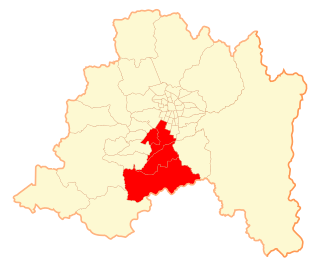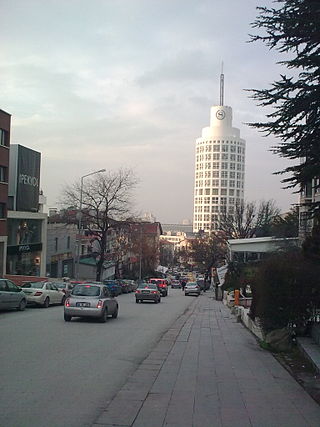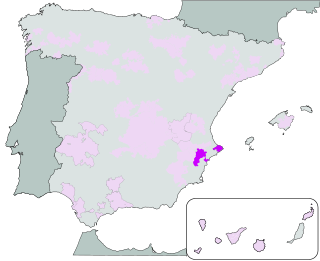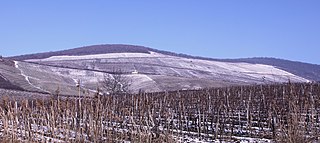
Chile has a long history in the production of wine, with roots dating back to the 16th century when the Spanish conquistadors introduced Vitis vinifera vines to the region. In the mid-19th century, French wine varieties such as Cabernet Sauvignon, Merlot, Carmenère, and Franc were introduced. During the early 1980s, the Chilean wine industry underwent a renaissance with the introduction of stainless steel fermentation tanks and the use of oak barrels for aging. This led to a rapid growth in exports as quality wine production increased. The number of wineries in Chile rose from 12 in 1995 to over 70 in 2005.

Maipo Province is one of six provinces in the Santiago Metropolitan Region of central Chile. Its capital is San Bernardo.

Washington wine is a wine produced from grape varieties grown in the U.S. state of Washington. Washington ranks second in the United States in the production of wine. By 2017, the state had over 55,000 acres (220 km2) of vineyards, a harvest of 229,000 short tons (208,000 t) of grapes, and exports going to over 40 countries around the world from the 940+ wineries located in the state. While there are some viticultural activities in the cooler, wetter western half of the state, the majority (99.9%) of wine grape production takes place in the shrub-steppe eastern half. The rain shadow of the Cascade Range leaves the Columbia River Basin with around 8 inches (200 mm) of annual rain fall, making irrigation and water rights of paramount interest to the Washington wine industry. Viticulture in the state is also influenced by long sunlight hours and consistent temperatures.

Limoux wine is produced around the city of Limoux in Languedoc in southwestern France. Limoux wine is produced under four Appellation d'origine contrôlée (AOC) designations: Blanquette de Limoux, Blanquette méthode ancestrale, Crémant de Limoux and Limoux, the first three of which are sparkling wines and dominate the production around Limoux. The main grape of the region is the Mauzac, locally known as Blanquette, followed by Chardonnay and Chenin blanc. In 2005, the Limoux AOC was created to include red wine production consisting of mostly Merlot. Wine historians believe that the world's first sparkling wine was produced in this region in 1531, by the monks at the abbey in Saint-Hilaire.

Kavaklıdere is one of the best known wineries in Turkey. Founded by the And family, it is located in Ankara and is named after a neighborhood in the city.
Kalecik Karası is a Turkish grape variety and a Turkish wine produced from this grape. This grape and wine are called by the name of area, the Kalecik district of Ankara Province, Turkey. Kalecik Karası grows successfully near Kalecik. In its homeland Kalecik, the microclimate created by Kızılırmak river and the soils rich in marine fossils offer optimum conditions to cultivate good quality Kalecik Karası.
Çal Karası is a variety of red wine grape from the Çal district of the Denizli Province of western Turkey. It also gives its name to a wine produced from the grape, which is sweet with berry fruit flavours.
Öküzgözü is a grape variety and a Turkish wine produced from this grape. The grape is one of the two native grape varieties of Elazığ Province, located on the Anatolian plateau at the north of the Taurus Mountains. The various sources of the Euphrates River in this region soften the normally harsh climate of Eastern Turkey.

Somontano is a Spanish Denominación de Origen Protegida (DOP) for wines, created in 1984, and located in the county of the same name, in the province of Huesca,. It borders the regions of Sobrarbe and Ribagorza in the North, Hoya de Huesca in the West, the Monegros in the South, and the region of Litera in the East. Wine production is centred on the town of Barbastro. The name Somontano, as its Latin roots suggest, means “beneath the mountain” – this perfectly defines this geographic area which spreads out from the foothills of the Pyrenees down to the Ebro valley. The DOP includes 43 municipalities, most of them in the Somontano area, and a few bordering on Ribagorza and the Monegros. There are over 4000 hectares of vines and about 500 individual grape-growers.

Alicante is a Spanish Denominación de Origen Protegida (DOP) for wines located in the province of Alicante.

Turkish wine is wine made in the transcontinental Eurasian country Turkey. The Caucasus region, where Armenia, Azerbaijan, Georgia and Iran are located, played a pivotal role in the early history of wine and is likely to have been one of the earliest wine-producing regions of the world.

Friuli-Venezia Giulia wine is wine made in the northeastern Italian region of Friuli-Venezia Giulia. There are 11 Denominazione di origine controllata (DOC) and 3 Denominazione di Origine Controllata e Garantita (DOCG) in the Friuli-Venezia Giulia area. The region has 3 Indicazione Geografica Tipica (IGT) designations Alto Livenza, delle Venezie and Venezia Giulia. Nearly 62% of the wine produced in the region falls under a DOC designation. The area is known predominantly for its white wines which are considered some of the best examples of Italian wine in that style. Along with the Veneto and Trentino-Alto Adige/Südtirol, the Friuli-Venezia Giulia forms the Tre Venezie wine region which ranks with Tuscany and Piedmont as Italy's world class wine regions.
Finca Élez is a Vino de Pago from Spain. This is the highest category on the quality scale of Spanish wines and means that in addition to having a proven track record of consistent quality, the wines have to be both produced from estate-grown grapes and also have to be processed and aged in a winery (bodega) located on the estate. This Vino de Pago is located in the municipality of El Bonillo, in the province of Albacete and acquired its status in 2002.
Dehesa del Carrizal is a Vino de Pago from Spain. This is the highest category on the quality scale of Spanish wines and means that in addition to having a proven track record of consistent quality, the wines have to be both produced from estate-grown grapes and also have to be processed and aged in a winery (bodega) located on the estate.
Boğazkere is a grape variety and a Turkish wine originated from Diyarbakır Province near the Tigris river in the southeastern region of Turkey. It is a dark red rich grape and the wine is well structured with dried fruit and fig flavors. It also gives its name to a wine produced from the grape by the certificated Boğazkere vineyards in Diyarbakır.

Adelaida Vineyards & Winery is a family-owned and operated winery that was named after a 19th-century settlement in the mountains of west Paso Robles, California. Situated at 2,000 feet (610 m) of elevation and 14 miles (23 km) from the Pacific Ocean, the terrain of the Adelaida, California district is marked by ancient calcareous soils, diurnal temperature variations of nearly 50 °F (10 °C), and warm, dry growing seasons. Adelaida Vineyards & Winery produces Cabernet Sauvignon, Pinot noir, Syrah, Rhône blends, Zinfandel and other wines from the Paso Robles AVA.

Cakebread Cellars is a Napa Valley winery known for its Chardonnay and Sauvignon Blanc wines, which are internationally distributed. Founded in 1973 by Jack and Dolores Cakebread in Rutherford, California, the winery produces approximately 200,000 cases of wine per year.

The Nagy-Eged Hill is an emblematic wine producing site. It is Hungary’s highest altitude terroir. Based on its unique location, soil composition and climate, it is the most valuable terroir in the region. It is Eger’s Grand Cru terroir.














